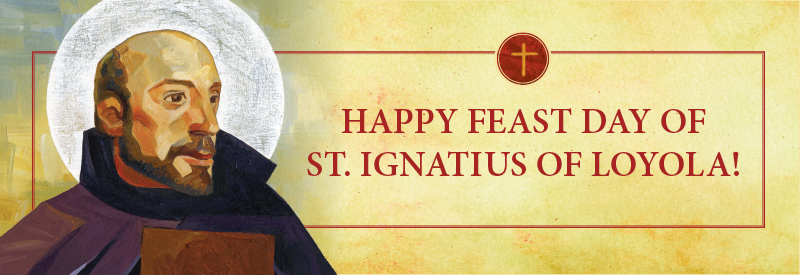Celebrate the Feast of St. Ignatius

“They gradually realized from the outside the change that had been made inwardly in his soul.” [Autobiography of St. Ignatius 10]
The first impression one gleans from the Shrine of Loyola in the Basque Country in Spain is that it was once home to a great and historic hero. The basilica rises up imposingly in the middle of the valley in contrast to the farmsteads so typical of the region. The high altar, with its marble altarpiece and fine inlays, is presided over by a magnificent statue of St. Ignatius, appearing triumphant and glorious. The side altars, the organ, and ornate dome bestow on the whole a note of solemn grandiosity. But, to the surprise of visitors, the guides who show them around the shrine never fail to invite them, as they leave the basilica, to see its “jewel.”
Passing through a side door marked “the holy house,” they enter the discreet, austere house concealed by the vast architecture of the shrine, where St. Ignatius was born. And there it is, invisible from the outside yet nourishing the shrine’s very soul. Half built of stone and half from brick, a consequence of futile battles, it begins to narrate a less glorious story. The next thing the visitor will see is a statue showing a wounded, failing Ignatius. Going up the stairs, one sees a depiction of his wild youth and his protector’s fall from grace… Further up still are the family quarters and the memory of the mother we are not sure Ignatius ever knew… finally on the top floor we arrive at the rooms of the children of the family, where the “chapel of conversion” is found: an austere, simple, serene place which testifies to the passage of God through the life of this wounded man, who reposed there, entertained in between his knightly fantasies by reading the life of Christ and those of the saints. The “jewel of the place” reminds us who is guiding us. Above the altar is an inscription in Basque and Spanish that reads: “Here, Íñigo de Loyola gave himself to God.” Here lies its value. In this discreet spot, God began to open a path in the heart of a wounded man, thus beginning the process of conversion which has touched the lives of so many.
PRAYER POINTS
The composition of place. Think of people you know who have experienced, despite their wounds or because of them, the Lord’s invitation and call to fullness of life.
Grace to ask for. Lord, give me a courageous and open outlook so that I may recognise you at work in my life and in the life of many others.
First point. Dwell on experiences of conversion, whether small or large, in your personal faith story.
BIBLE TEXTS
- Ephesians 1:3–14. What do you feel when you read that you are loved prior to any effort or merit on your part? And what if the purpose of your life were to offer to the world the love you have received freely? What would this change for you? Where would you focus your efforts on a daily basis?
- Jeremiah 18:1–6. The invitation of the prophet Jeremiah is to allow ourselves to be moulded by the Lord. How do you cope with times of vulnerability? Do they become times when you turn inwards, or do they stir up a longing to trust others? Which of your experiences of God have helped you grow in trust with him?
- Luke 5:1–11. “Go away from me, Lord; I am a sinful man!” Those were the words of Peter to Jesus after the miraculous catch of fish. Jesus invited Peter to be a “fisher of men.” Are you willing to hear the Lord’s invitations? What is he inviting you to do? What have been the fruits of allowing yourself to be led by him in times of despair?
Colloquy. Speak to Mary, tell her about the desires and longings you have in your personal process of faith and ask her to obtain for you the grace from her Son so that you may grow in trust regarding his call and invitations. Finish with an Our Father and a Hail Mary. Do not forget to examine what you have experienced during the prayer time.
 |
—Excerpted from Walking with Ignatius by Arturo Sosa, SJ |

